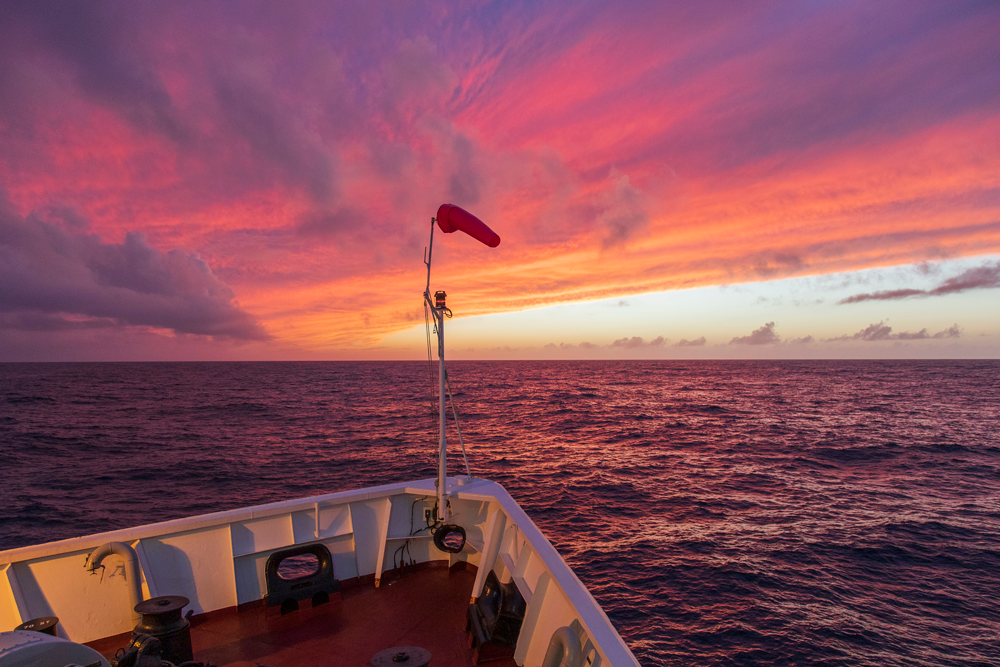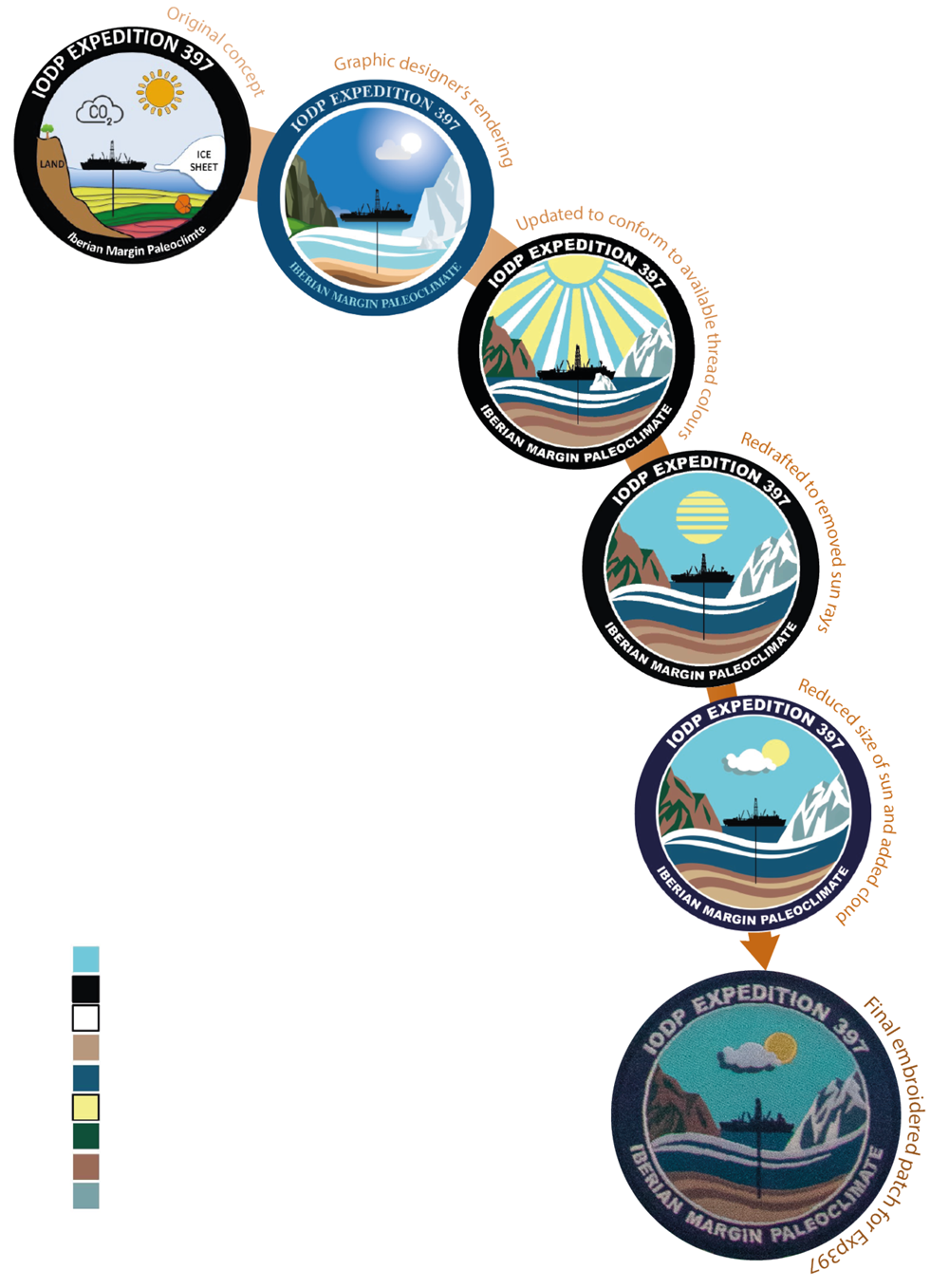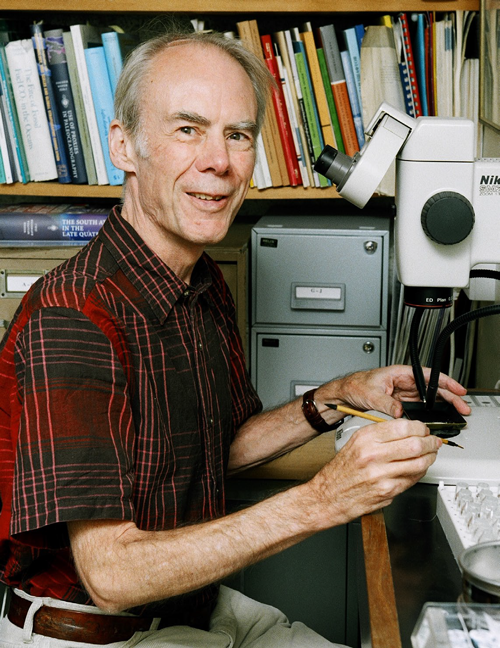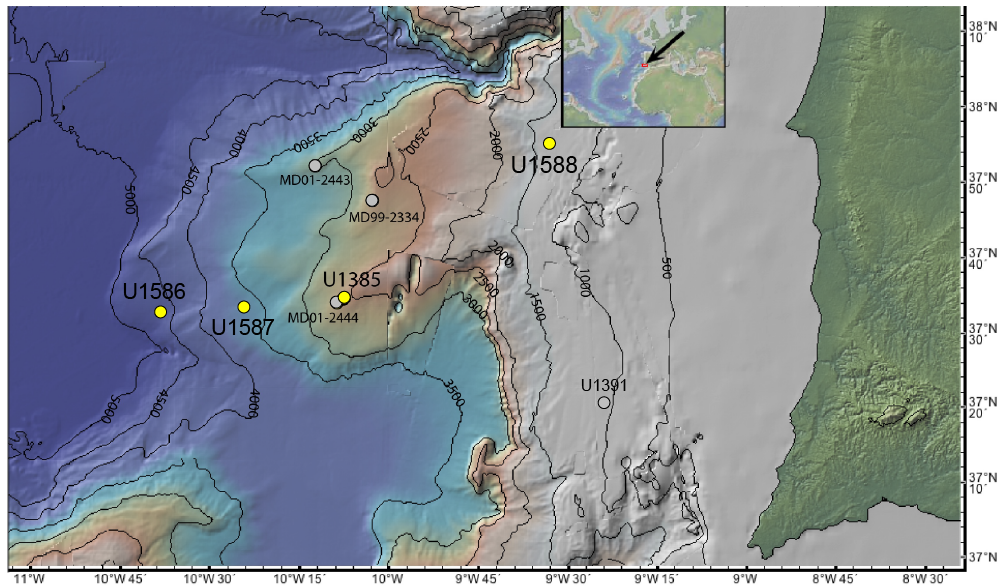Proceedings of the International Ocean Discovery Program
Volume 397
Iberian Margin Paleoclimate
Expedition 397 of the R/V JOIDES Resolution
Lisbon, Portugal, to Tarragona, Spain
Sites U1385 and U1586–U1588
11 October–11 December 2022
Volume authorship
Hodell, D.A., Abrantes, F., Alvarez Zarikian, C.A., and the Expedition 397 Scientists

Published by
International Ocean Discovery Program

Frontispiece. Evolution of the Expedition 397 patch. The patch evolved from a concept sketch produced by Co-Chief Scientist David Hodell to a graphic design done by José Manuel Abrantes to a vector graphic produced by Alyssa Stephens at IODP to conform to the available thread colours (swatch) and maximum colour constraints available by the company that stitches the patches. The concept we wanted to convey for Expedition 397 is how marine sediments from the Iberian margin can be linked to polar ice cores and European terrestrial sequences.
Publisher’s notes
This publication was prepared by the JOIDES Resolution Science Operator (JRSO) at Texas A&M University (TAMU) as an account of work performed under the International Ocean Discovery Program (IODP). This material is based upon work supported by the JRSO, which is a major facility funded by the National Science Foundation Cooperative Agreement Number OCE1326927. Funding for IODP is provided by the following international partners:
- National Science Foundation (NSF), United States
- Ministry of Education, Culture, Sports, Science and Technology (MEXT), Japan
- European Consortium for Ocean Research Drilling (ECORD)
- Ministry of Science and Technology (MOST), People's Republic of China
- Australia-New Zealand IODP Consortium (ANZIC)
- Ministry of Earth Sciences (MoES), India
The JRSO is supported by the NSF. Any opinions, findings, and conclusions or recommendations expressed in this material do not necessarily reflect the views of the NSF, the participating agencies, TAMU, or Texas A&M Research Foundation.
The bulk of the shipboard-collected core data from this expedition is accessible at https://zenodo.org/communities/iodp (see list of available data sets). If you cannot access this site or need additional data, please contact Data Librarian, International Ocean Discovery Program JOIDES Resolution Science Operator, Texas A&M University (database@iodp.tamu.edu).
A complete set of the logging data collected during the expedition is available at http://mlp.ldeo.columbia.edu/logdb/scientific_ocean_drilling. If you have problems downloading the data, wish to receive additional logging data, or have questions regarding the data, please contact Database Administrator, Borehole Research Group, Lamont-Doherty Earth Observatory of Columbia University (logdb@ldeo.columbia.edu).
Supplemental data were provided by the authors and may not conform to IODP publication formats.
JRSO expedition photos are the property of IODP and are public access.
Some core photographs have been tonally enhanced to better illustrate particular features of interest. High-resolution images are available upon request.
Cover photograph shows sunset at Site U1586, Expedition 397. Photo credit: Carlos Alvarez Zarikian, IODP JRSO.
Copyright

Examples of how to cite this volume or part of this volume are available at http://publications.iodp.org/
ISSN
ISBN
Volume DOI
https://doi.org/10.14379/iodp.proc.397.2024
Publication date
Contents
Expedition reports
Chapters
PDF
Figures (415 MB)
Table
Cited by
PDF
Figures (34 MB)
Tables
Cited by
PDF
Figures (464 MB)
Tables
Cited by
PDF
Figures (342 MB)
Tables
Cited by
PDF
Figures (332 MB)
Tables
Cited by
PDF
Figures (258 MB)
Tables
Cited by
Core descriptions
Visual core descriptions (VCDs) are presented in PDF files for each site.
Thin sections and/or smear slides for each site or hole are presented in tab-separated value (TSV) or PDF format in the CORES directory and in TSV format in GEODESC in Supplementary material. The entire set of core images in PDF is available in the IMAGES directory.
Site U1586: Visual core descriptions · Smear slides · Thin sections
Site U1587: Visual core descriptions · Smear slides
Site U1385: Visual core descriptions · Smear slides
Site U1588: Visual core descriptions · Smear slides
Supplementary material
Supplementary material for the Volume 397 expedition reports includes GEODESC workbooks in tab-separated value (TSV) format. A full list of directories can be found in SUPP_MAT in the volume zip folder or on the Supplementary material for Volume 397 expedition reports web page.
Expedition research results
Data reports
P. Blum et al.
PDF
Figures
Supplementary material
Cited by
Data report: an improved splice using XRF data, IODP Expedition 397 Site U1586
F. Abrantes et al.
PDF
Figures
Tables
Supplementary material
Cited by
Drilling location maps
A site map showing the drilling locations for this expedition and maps showing the drilling locations of all International Ocean Discovery Program (IODP) expeditions, produced using QGIS (http://www.qgis.org), and all Integrated Ocean Drilling Program, Ocean Drilling Program (ODP), and Deep Sea Drilling Project (DSDP) expeditions, produced using Generic Mapping Tools (GMT) of Paul Wessel and Walter H.F. Smith (https://www.generic-mapping-tools.org), are available in PDF.
- IODP Expedition 397 site map
- IODP map
- Integrated Ocean Drilling Program map (Expeditions 301–348)
- ODP map (Legs 100–210)
- DSDP map (Legs 1–96)
Dedication
Sir Nicholas (Nick) Shackleton
(23 June 1937–24 January 2006)


We dedicate IODP Expedition 397 to the late Sir Nicholas (Nick) Shackleton (23 June 1937–24 January 2006), whose dream it was for the R/V JOIDES Resolution to drill the Iberian margin. He would have undoubtedly led this effort had he lived longer. Nick was a staunch advocate of the Deep Sea Drilling Project (DSDP) and its successor, the Ocean Drilling Program (ODP), and a prolific contributor of 53 papers and data reports to the scientific reports volumes of those programs between 1972 and 1998 (McCave and Elderfield, 2011). He sailed on four legs of the D/V Glomar Challenger and R/V JOIDES Resolution, including Legs 74 (Walvis Ridge), 138 (Eastern Equatorial Pacific), 154 (Ceara Rise; Co-Chief Scientist), and 171B (Blake Nose). Nick's research on piston cores from the Iberian margin began with his involvement in the International Marine Global Change Study (IMAGES) program and sailing on its inaugural cruise, Cruise MD095, which was the first opportunity to use a newly developed long piston coring system to recover Iberian margin sediment. The initially planned seven coring locations, including a site requested by Nick to investigate the potential for a direct land-sea correlation, had to be reduced to four owing to technical problems. When faced with the need to reduce the number of sites, he did not hesitate giving up his coring interests for the common good of the group. Nonetheless, his subsequent work on Core MD95-2042 proved hugely influential in demonstrating the potential of these sediments to capture millennial climate variability and correlating them to the polar ice cores and European pollen sequences. Nick foremost considered himself to be a stratigrapher and paid meticulous attention to stratigraphic correlation and the establishment of precise chronologies, often using cyclostratigraphy. Following his lead, we paid close attention to covering the core gaps in multiple holes at each of the Expedition 397 sites to produce complete stratigraphic sequences. The strong precession cycles at Expedition 397 sites are reminiscent of Nick's classic work using sediment cores from Legs 138 and 154, which he used to develop orbitally tuned timescales. Indeed, he would have relished the opportunity to astronomically tune the exquisite cycles that are pervasive in Expedition 397 sequences.
Photo credit: McCave, I.N., and Elderfield, H. E., 2011. Sir Nicholas John Shackleton, 2011, Sir Nicholas John Shackleton, Biogr. Mems Fell. R. Soc, 57, 435-462, doi:10.1098/rsbm.2011.0005
Image of first-class UK postage stamp from The Royal Society 350 Years series released in 2010, featuring Nick Shackleton and his foraminifers.
Acknowledgments

Timeline and milestones for Expedition 397 from concept in 2009 to completion in 2022.
IODP Expedition 397 represents the culmination of over a decade of planning. It takes a village to successfully execute an IODP expedition, and it would not have been possible without the support of many individuals, groups, and agencies. We thank the ECORD Magellan Programme for funding the initial planning workshop in 2009 when the seeds for drilling the Iberian margin were first planted. We adopted a strategy of submitting two parallel drilling proposals: (1) an Ancillary Project Letter (APL-763) proposing a single site that was drilled as Site U1385 during Integrated Ocean Drilling Program Expedition 339 in late 2011 and (2) IODP 771-Full, which outlined plans for a full expedition that became Expedition 397 in 2022. We thank all the proponents of these proposals, many of whom did not get the opportunity to sail on Expedition 397.
We thank the scientists and crew of Expedition 339 who recovered Site U1385, especially Co-Chiefs Javier Hernandez-Molina and Dorrick Stow, who graciously sacrificed 4 days of operations, providing the proof-of-concept needed for Expedition 397.
Early on it was clear that we didn't possess all the necessary site survey data to support a full expedition, so we conducted a site survey cruise (JC089) in 2013 aboard the RRS James Cook that collected critical seismic and core data to support the drilling proposal. We thank IODP-UK and the Natural Environment Research Council (NERC) for funding the cruise and all the scientists and crew who sailed on Survey Cruise JC089. Ross Parnell-Turner, Nicky White, Gabriella Carrara, Pedro Terrinha, and Luis Batista provided invaluable assistance interpreting seismic profiles used for selecting Expedition 397 sites.
We are indebted to Trevor Williams, who recommended the use of the polycrystalline diamond compact (PDC) bit, which proved instrumental for the excellent extended core barrel (XCB) cores obtained during Expedition 397. Peter Blum provided valuable training for the new software (GeoDESC and Correlator 4.04) trialled during Expedition 397. We thank José Manuel Abrantes for designing the Expedition 397 patch and Helder Pereira for making the site location maps.
Foremost, the scientific party thanks the drillers, crew, catering, and scientific technical staff of JOIDES Resolution for their hard work and consummate professionalism throughout Expedition 397. Core Technicians Joe (Bubba) Attryde and Phil Christie are thanked for their ingenuity and experience in obtaining high quality cores. This was Bubba's last expedition before his retirement following 47 years of dedicated service to scientific ocean drilling. We thank Master Jake Robinson and his crew for smooth operation of the vessel and successfully managing the COVID-19 challenges with great care and caution. The IODP scientific technical team were outstanding under the leadership of Lisa Crowder and ensured the reliable operations of the laboratories. Moreover, they provided a warm and welcoming environment and made all of the scientists feel at home. We thank Entier Ltd. staff for providing exceptional shipboard service and keeping us well fed aboard JOIDES Resolution.
Disappointed by the recent decision of the nonrenewal of JOIDES Resolution, we are nonetheless grateful to the pioneers of the initial Deep Sea Drilling Project and the thousands of scientists, administrators, and support staff who labored tirelessly throughout the different phases of the scientific drilling program to make it the huge success it has been. And lastly, we acknowledge JOIDES Resolution for being such a reliable instrument for new and wonderful scientific discovery throughout her lifespan.
Foreword
The International Ocean Discovery Program (IODP) represents the latest incarnation of almost five decades of scientific ocean drilling excellence and is generally accepted as the most successful international collaboration in the history of the Earth sciences. IODP builds seamlessly on the accomplishments of previous phases: the Deep Sea Drilling Project, Ocean Drilling Program, and Integrated Ocean Drilling Program. The 2013–2023 IODP Science Plan (Illuminating Earth's Past, Present, and Future) defines four themes and thirteen challenges for this decade of scientific ocean drilling that are both of fundamental importance in understanding how the Earth works and of significant relevance to society as the Earth changes, at least in part in response to anthropogenic forcing. This phase of IODP represents an intense level of international collaboration in bringing diverse drilling platforms and strategies to increasing our understanding of climate and ocean change, the deep biosphere and evolution of ecosystems, connections between Earth's deep processes and surface manifestations, and geologically induced hazards on human timeframes.
The Proceedings of the International Ocean Discovery Program presents the scientific and engineering results of IODP drilling projects, expedition by expedition. As in the preceding Integrated Ocean Drilling Program, expeditions in the current IODP phase are conducted by three implementing organizations, each providing a different drilling capability. These are the US Implementing Organization (USIO; through September 2014) and the JOIDES Resolution Science Operator (JRSO; as of October 2014), providing the leased commercial vessel JOIDES Resolution for riserless drilling operations; JAMSTEC's Institute for Marine-Earth Exploration and Engineering (MarE3), providing the drillship Chikyu for riser and occasional riserless operations; and the European Consortium for Ocean Research Drilling (ECORD) Science Operator (ESO), providing "mission-specific" platforms (MSPs) for expeditions that extend the IODP operational range where neither drillship is suitable, for example, in polar environments and in shallow waters. Scheduling decisions for each capability are made by three independent Facility Boards, each of which includes scientists, operators, and platform funding partners: the JOIDES Resolution Facility Board (JRFB), Chikyu IODP Board (CIB), and ECORD Facility Board (EFB). At the beginning of the current IODP, the three Facility Boards agreed to utilize Publication Services at the USIO and now the JRSO for production of all expedition Proceedings volumes and reports.
The current IODP differs from prior scientific ocean drilling programs in that it has neither a central management organization nor commingled funding for program-wide activities. Yet this phase of IODP retains a fundamental integrative structural element: a "bottom-up" evaluation of all proposals for drilling expeditions by a single advisory structure composed of scientists representing all international program partners. International scientists may submit drilling proposals to the Science Support Office; all submitted proposals are then evaluated by a Science Evaluation Panel in the context of the Science Plan.
The current IODP also has an international integrative level for high-level discussion and global consensus-building: the IODP Forum. The Forum is not only charged with assessing program-wide progress toward achieving the current Science Plan, but also with overseeing approaches toward a new bright future of scientific ocean drilling post 2023. At present, IODP involves 22 international funding agencies, including those from the United States, Japan, an Australia/New Zealand consortium (ANZIC), China, India, South Korea, and the 15 members of ECORD (Austria, Canada, Denmark, Finland, France, Germany, Ireland, Italy, the Netherlands, Norway, Portugal, Spain, Sweden, Switzerland, and the United Kingdom). The IODP membership represents an unparalleled level of international scientific collaboration; one of the greatest and ongoing strengths of scientific ocean drilling.
Henk Brinkhuis
Chair, IODP Forum
Reviewers for this volume
Thomas Ronge
Matthias Sinnesael
International Ocean Discovery Program
JOIDES Resolution Science Operator
Website: http://iodp.tamu.edu
IODP JRSO
International Ocean Discovery Program
Tel: (979) 845-2673; Fax: (979) 845-4857
Email: information@iodp.tamu.edu
IODP JRSO Curation and Laboratories
IODP Gulf Coast Repository (GCR)
Tel: (979) 845-8490; Fax: (979) 845-1303
Email: curator@iodp.tamu.edu
European Consortium for Ocean Research Drilling, Science Operator (ESO)
Website: http://www.ecord.org
IODP ESO Coordinator: Science, Logistics, and Operations
Tel: (44) 131-667-1000; Fax: (44) 131-668-4140
Email: eso@bgs.ac.uk
IODP ESO Petrophysics
European Petrophysics Consortium
Tel: (44) 116-252-3611; Fax: (44) 116-252-3918
Email: sjd27@leicester.ac.uk
IODP ESO Curation and Laboratories
IODP Bremen Core Repository (BCR)
Center for Marine Environmental Sciences (MARUM)
Tel: (49) 421-218-65560; Fax: (49) 421-218-98-65560
Email: bcr@marum.de
Japan Agency for Marine-Earth Science and Technology (JAMSTEC)
Website: http://www.jamstec.go.jp/chikyu/e
IODP Japan Science Operator
Institute for Marine-Earth Exploration and Engineering (MarE3)
Japan Agency for Marine-Earth Science and Technology
Yokohama Institute for Earth Sciences
Tel: (81) 45-778-5643; Fax: (81) 45-778-5704
Email: mare3-exp@jamstec.go.jp
IODP Japan Curation and Laboratories
IODP Kochi Institute for Core Sample Research (KCC)
Japan Agency for Marine-Earth Science and Technology
Tel: (81) 88-864-6705; Fax: (81) 88-878-2192
Email: kcc.contact@jamstec.go.jp
Expedition 397 participants*
Expedition 397 scientists
Marine Geology and Georesources Division
Portuguese Institute of the Sea and Atmosphere (IPMA)
Centre of Marine Sciences (CCMAR)
Expedition Project Manager/Staff Scientist
International Ocean Discovery Program
Energy and Mineral Resources Group
hannah.brooks@emr.rwth-aachen.de
Micropaleontologist (nannofossils)
Department of Geological Sciences
Institut de Physique du Globe de Paris
Department of Earth, Atmosphere, and Environment
Micropaleontologist (nannofossils)
Department of Geological Sciences
Department of Marine Chemistry and Geochemistry
Woods Hole Oceanographic Institution
Physical Properties and Downhole Measurements Specialist/Stratigraphic Correlator
National Museum of Natural History
Present affiliation (May 2025):
Department of Geosciences
Princeton University
USA
Physical Properties and Downhole Measurements Specialist
Physical Properties and Downhole Measurements Specialist
Atmosphere and Ocean Research Institute (AORI)
Institute of Environmental Physics
jasmin.link@iup.uni-heidelberg.de
Lamont-Doherty Earth Observatory
Earth, Environmental, and Planetary Sciences
Department of Geology and Geophysics
Department of Earth and Environmental Sciences
Micropaleontologist (planktonic foraminifera)
Environnements et Paléoenvironnements Océaniques et Continentaux EPOC -UMR
Marine Geology and Georesources Division
Portuguese Institute of the Sea and Atmosphere (IPMA)
Centre of Marine Sciences (CCMAR)
Physical Properties and Downhole Measurements Specialist
College of Earth, Ocean, and Atmospheric Sciences
Micropaleontologist (planktonic foraminifera)
School of Ocean and Earth Science
Research School of Earth Sciences
Australian National University
Outreach
Lamont-Doherty Earth Observatory
*Affiliations at time of expedition, except where updated by participants.
Operational and technical staff
Siem Offshore AS officials
JRSO shipboard personnel and technical representatives
Marine Instrumentation Specialist
Marine Instrumentation Specialist
IODP Publication Services staff*
Manager of Publication Services
Expedition-related bibliography*
Citation data for IODP publications and journal articles in RIS format
IODP publications
Scientific Prospectus
Hodell, D.A., Abrantes, F., and Alvarez Zarikian, C.A., 2022. Expedition 397 Scientific Prospectus: Iberian Margin Paleoclimate. International Ocean Discovery Program. https://doi.org/10.14379/iodp.sp.397.2022
Preliminary Report
Hodell, D.A., Abrantes, F., Alvarez Zarikian, C.A., and the Expedition 397 Scientists, 2023. Expedition 397 Preliminary Report: Iberian Margin Paleoclimate. International Ocean Discovery Program. https://doi.org/10.14379/iodp.pr.397.2023
Proceedings volume
Hodell, D.A., Abrantes, F., Alvarez Zarikian, C.A., and the Expedition 397 Scientists, 2024. Iberian Margin Paleoclimate. Proceedings of the International Ocean Discovery Program, 397: College Station, TX (International Ocean Discovery Program). https://doi.org/10.14379/iodp.proc.397.2024
Expedition reports
Hodell, D.A., Abrantes, F., Alvarez Zarikian, C.A., Brooks, H.L., Clark, W.B., Dauchy-Tric, L.F.B., dos Santos Rocha, V., Flores, J.-A., Herbert, T.D., Hines, S.K.V., Huang, H.-H.M., Ikeda, H., Kaboth-Bahr, S., Kuroda, J., Link, J.M., McManus, J.F., Mitsunaga, B.A., Nana Yobo, L., Pallone, C.T., Pang, X., Peral, M.Y., Salgueiro, E., Sanchez, S., Verma, K., Wu, J., Xuan, C., and Yu, J., 2024. Expedition 397 summary. In Hodell, D.A., Abrantes, F., Alvarez Zarikian, C.A., and the Expedition 397 Scientists, Iberian Margin Paleoclimate. Proceedings of the International Ocean Discovery Program, 397: College Station, TX (International Ocean Discovery Program). https://doi.org/10.14379/iodp.proc.397.101.2024
Abrantes, F., Hodell, D.A., Alvarez Zarikian, C.A., Brooks, H.L., Clark, W.B., Dauchy-Tric, L.F.B., dos Santos Rocha, V., Flores, J.-A., Herbert, T.D., Hines, S.K.V., Huang, H.-H.M., Ikeda, H., Kaboth-Bahr, S., Kuroda, J., Link, J.M., McManus, J.F., Mitsunaga, B.A., Nana Yobo, L., Pallone, C.T., Pang, X., Peral, M.Y., Salgueiro, E., Sanchez, S., Verma, K., Wu, J., Xuan, C., and Yu, J., 2024. Expedition 397 methods. In Hodell, D.A., Abrantes, F., Alvarez Zarikian, C.A., and the Expedition 397 Scientists, Iberian Margin Paleoclimate. Proceedings of the International Ocean Discovery Program, 397: College Station, TX (International Ocean Discovery Program). https://doi.org/10.14379/iodp.proc.397.102.2024
Abrantes, F., Hodell, D.A., Alvarez Zarikian, C.A., Brooks, H.L., Clark, W.B., Dauchy-Tric, L.F.B., dos Santos Rocha, V., Flores, J.-A., Herbert, T.D., Hines, S.K.V., Huang, H.-H.M., Ikeda, H., Kaboth-Bahr, S., Kuroda, J., Link, J.M., McManus, J.F., Mitsunaga, B.A., Nana Yobo, L., Pallone, C.T., Pang, X., Peral, M.Y., Salgueiro, E., Sanchez, S., Verma, K., Wu, J., Xuan, C., and Yu, J., 2024. Site U1586. In Hodell, D.A., Abrantes, F., Alvarez Zarikian, C.A., and the Expedition 397 Scientists, Iberian Margin Paleoclimate. Proceedings of the International Ocean Discovery Program, 397: College Station, TX (International Ocean Discovery Program). https://doi.org/10.14379/iodp.proc.397.103.2024
Hodell, D.A., Abrantes, F., Alvarez Zarikian, C.A., Brooks, H.L., Clark, W.B., Dauchy-Tric, L.F.B., dos Santos Rocha, V., Flores, J.-A., Herbert, T.D., Hines, S.K.V., Huang, H.-H.M., Ikeda, H., Kaboth-Bahr, S., Kuroda, J., Link, J.M., McManus, J.F., Mitsunaga, B.A., Nana Yobo, L., Pallone, C.T., Pang, X., Peral, M.Y., Salgueiro, E., Sanchez, S., Verma, K., Wu, J., Xuan, C., and Yu, J., 2024. Site U1587. In Hodell, D.A., Abrantes, F., Alvarez Zarikian, C.A., and the Expedition 397 Scientists, Iberian Margin Paleoclimate. Proceedings of the International Ocean Discovery Program, 397: College Station, TX (International Ocean Discovery Program). https://doi.org/10.14379/iodp.proc.397.104.2024
Hodell, D.A., Abrantes, F., Alvarez Zarikian, C.A., Brooks, H.L., Clark, W.B., Dauchy-Tric, L.F.B., dos Santos Rocha, V., Flores, J.-A., Herbert, T.D., Hines, S.K.V., Huang, H.-H.M., Ikeda, H., Kaboth-Bahr, S., Kuroda, J., Link, J.M., McManus, J.F., Mitsunaga, B.A., Nana Yobo, L., Pallone, C.T., Pang, X., Peral, M.Y., Salgueiro, E., Sanchez, S., Verma, K., Wu, J., Xuan, C., and Yu, J., 2024. Site U1385. In Hodell, D.A., Abrantes, F., Alvarez Zarikian, C.A., and the Expedition 397 Scientists, Iberian Margin Paleoclimate. Proceedings of the International Ocean Discovery Program, 397: College Station, TX (International Ocean Discovery Program). https://doi.org/10.14379/iodp.proc.397.105.2024
Abrantes, F., Hodell, D.A., Alvarez Zarikian, C.A., Brooks, H.L., Clark, W.B., Dauchy-Tric, L.F.B., dos Santos Rocha, V., Flores, J.-A., Herbert, T.D., Hines, S.K.V., Huang, H.-H.M., Ikeda, H., Kaboth-Bahr, S., Kuroda, J., Link, J.M., McManus, J.F., Mitsunaga, B.A., Nana Yobo, L., Pallone, C.T., Pang, X., Peral, M.Y., Salgueiro, E., Sanchez, S., Verma, K., Wu, J., Xuan, C., and Yu, J., 2024. Site U1588. In Hodell, D.A., Abrantes, F., Alvarez Zarikian, C.A., and the Expedition 397 Scientists, Iberian Margin Paleoclimate. Proceedings of the International Ocean Discovery Program, 397: College Station, TX (International Ocean Discovery Program). https://doi.org/10.14379/iodp.proc.397.106.2024
Supplementary material
Hodell, D.A., Abrantes, F., Alvarez Zarikian, C.A., and the Expedition 397 Scientists, 2024. Supplementary material, https://doi.org/10.14379/iodp.proc.397supp.2024. In Hodell, D.A., Abrantes, F., Alvarez Zarikian, C.A., and the Expedition 397 Scientists, Iberian Margin Paleoclimate. Proceedings of the International Ocean Discovery Program, 397: College Station, TX (International Ocean Discovery Program).
Expedition research results
Blum, P., Huang, H.-H.M., Herbert, T., Hodell, D.A., Abrantes, F., and Alvarez Zarikian, C.A., 2025. Data report: implications of using the CSF-B depth scale type for stratigraphic correlation at IODP Expedition 397 Site U1588. In Hodell, D.A., Abrantes, F., Alvarez Zarikian, C.A., and the Expedition 397 Scientists, Iberian Margin Paleoclimate. Proceedings of the International Ocean Discovery Program, 397: College Station, TX (International Ocean Discovery Program). https://doi.org/10.14379/iodp.proc.397.201.2025
Abrantes, F., Magalhães, V., Hodell, D.A., Herbert, T.D., Alonso-Garcia, M., Castaño, M., Ferreira, F., Freitas, M., Gebara, L., Gil, I., Gonzáles-Martín, M., Lopes, A., Lopes, C., Matos, L., Mega, A., Molina, G., Naughton, F., Oliveira, D., Rebotim, A., Rodrigues, T., Salgueiro, E., Santana, A., Treyos-Tamayo, R., Alvarez Zarikian, C.A., and the Expedition 397 Scientists, 2025. Data report: an improved splice using XRF data, IODP Expedition 397 Site U1586. In Hodell, D.A., Abrantes, F., Alvarez Zarikian, C.A., and the Expedition 397 Scientists, Iberian Margin Paleoclimate. Proceedings of the International Ocean Discovery Program, 397: College Station, TX (International Ocean Discovery Program). https://doi.org/10.14379/iodp.proc.397.202.2025
Journals/Books
Chen, X., Wu, J., Pang, X., Dang, H., Zhong, L., Yu, J., Colin, C., Liu, Z., de Lange, G.J., Kaboth-Bahr, S., Xuan, C., Ikeda, H., Herbert, T.D., May Huang, H.-H., Alvarez Zarikian, C.A., Abrantes, F.F.G., and Hodell, D.A., 2025. Depth fluctuations of Mediterranean Outflow Water along its northward propagation during the Late Pleistocene. Geophysical Research Letters, 52(14):e2025GL116967. https://doi.org/10.1029/2025GL116967
Yin, S., Hernández-Molina, F.J., Fan, W., and Li, J., 2024. Efficient organic carbon burial by bottom currents in the ocean: a potential role in climate modulation. Geophysical Research Letters, 51(14):e2024GL109444. https://doi.org/10.1029/2024GL109444
Conferences
Hodell, D., Fatima, A., Zarikian, C., and the IODP Expedition 397 Scientists, 2023. Benchmark sedimentary records recovered from the Iberian margin during IODP Expedition 397. Presented at the EGU General Assembly 2023, Vienna, Austria, 24–28 April 2023. https://doi.org/10.5194/egusphere-egu23-16019
Hodell, D.A., Abrantes, F.F.G., Alvarez Zarikian, C.A., and the Expedition 397 Scientific Party and XRF Scanning Team, 2023. Co-evolution of millennial and orbital climate variability during the intensification of Northern Hemisphere glaciation in the Late Pliocene. Presented at the 2023 American Geophysical Union Fall Meeting, San Francisco, CA, 11–15 December 2023.
*The Expedition-related bibliography is continually updated online. Please send updates to PubCrd@iodp.tamu.edu.
Site map
